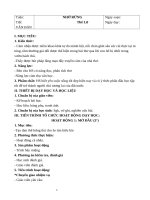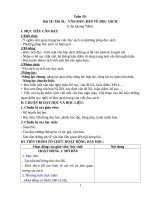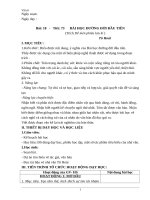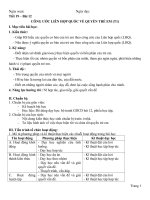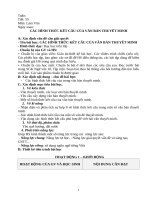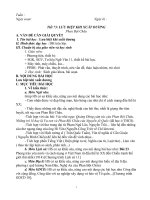Giáo án tiếng anh 8 soạn cv 3280 và 5512 (kì 2)
Bạn đang xem bản rút gọn của tài liệu. Xem và tải ngay bản đầy đủ của tài liệu tại đây (570.22 KB, 186 trang )
1
Week 20 - Period 58
Date of preparing: 10 /01/2021
Date of teaching:
UNIT 9: A FIRST-AID COURSE
Lesson 4: Write
Subject: English 8; Class: 8A, 8B
Time: 1 period
A.Objectives:
1.Knowledge : By the end of the lesson, students will be able to write a thankyou note to their friend
2. Competencies: coperation, creativeness, self study.
3. Behavior: SS are excited about writing a thank-you note.
II. Teaching aids:
1. Teacher:English 8, reference book, poster
2. Students: English 8, notebook.
III. Procedure
1.Activity 1: Warm up( 5')
a.Aims: Help students to review how to write an an informal letter, then lead in
the lesson.
b.Contents: write an informal letter.
c.Outcome: Ss’answers.
d.Organization:
Teacher’s activities
Students’ activities
Brainstorming
- asks Ss two questions:
+ How many parts are there in an informal
letter?
+ What should each part include?
- calls some groups to check
- gives feedback and corrects, then asks Ss
some more questions:
+ When do you write a thank-you note?
+ Have you ever written or received a thankyou note?
- introduces the lesson: Today you are going
to learn to write a thank-you note
- discuss the questions in groups
of 4
- call out the answers
- answer the questions(WC )
- pay attention
.
2.Activity 2: Pre- writing (12’)
a.Aims: Students understand the content of the thank-you note and know how to
write a thank-you note.
b.Contents: Complete the thank-you note.
c.Outcome: Ss’ answers.
2
d.Organization:
Teacher’s activities
Gap-fill: Ex1-P84
- gives instructions: Complete the thank-you note
Nga sent to Hoa after she left the hospital. Use the
correct tense forms of the verbs in brackets
- asks Ss to complete the letter
- gets feedback and corrects
Answer key
1. was
4. came
2. were
5. am
3. helped
6. will phone
Comprehension questions: (poster)
- asks Ss some questions
1. What did Hoa sent Nga?
2. When did she sent her?
3. What were they like?
4. How does Nga feel now?
5. Does she want to invite Hoa to her place on
the weekend?
6. How will she contact Hoa?
- gives feedback and corrects
- explains some more about how to write a thankyou note
Students’ activities
- pay attention
- work in pairs
- call out the answers
- answer the questions (WC)
- pay attention
3.Activity 3: While- Post writing (20’)
a.Aims: Ss can write an complete thank –you letter.
b.Contents: write a thank-you note to a friend. Invite your friend to go on a
picnic with you and arrange to contact your friend.
c.Outcome: Students’answer.
d.Organization:
Teacher’s activities
Students’ activities
3
Exercise 2- P85
- gives instructions: Now write a thank-you
note to a friend. Invite your friend to go on
a picnic with you and arrange to contact
your friend. Use the guiding questions and
refer to the model letter in Ex1-P84
- asks Ss to write their letters
- monitors and helps weaker students
Correction
- asks students to swap their writing and
correct mistakes for each other
- calls on some Ss to read out their letters
- gives feedback and corrects mistakes
- pay attention
- work individually
- swap and correct mistakes for
each other
- read aloud the letter
4.Activity 4: Application ( 8')
a.Aims: further practice
b.Contents: Write another letter to another friend for other occasions.
c.Outcome: students’ answer.
d.Organization:
Teacher’s activities
Students’ activities
Exercise 3- P85
-Write another letter to another friend for other - Pay attention to T.
- work in groups
occasions using the same format.
- asks Ss to work in groups to write their letters
- Write the letter.
- monitors and helps weaker students
Correction
- asks students to swap their writing and correct
mistakes for each other
- calls on some Ss to read out their letters
- gives feedback and corrects mistakes
- Copy
- Write the letter in your notebook
- Prepare Unit 9: Language focus
4
Week 20 - Period 59
Date of preparing:10/01/2021
Date of teaching:
UNIT 9: A FIRST-AID COURSE
Lesson 5: Language focus
Subject: English 8; Class: 8A, 8B
Time: 1 period
I.Objectives:
1. Knowledge: Giving students further practice in “Future Simple tense, making
requests, offers & promises and in order to/ so as to” to talk about purposes.
- By the end of the lesson, students will be able to do all the exercises using
these grammar items.
2. Competences: Co-operation, communication, self-study, creativeness, solving
problems, using language.
+ Totalizing knowledge to do exercises. Speaking, reading and writing.
3. Behavior: Ss love English and take part in the lesson actively and effectively.
II. Teaching aids:
- Teacher: Textbook, workbook, handouts.
- Students: Prepare Language focus
+ Prepare some grammar items “in order to; so as to”, revise the future simple
tense and model will to make requests, offers and promises.
III. Procedure:
1. Activity 1. Warm up (5’)
a. Aim: Check students’ knowledge from the privous lesson. And lead in the new
lesson.
b. Content: read out the thank-you note they wrote at home.
c. Outcome: the grammar items in unti 9
d. Organization:
Teacher’s activities
Students’ activities
1. Setting the class:
2. Check the old lesson:
- Call some Ss to read out the thank- T- St
- Read the thank – you note
you note they wrote at home.
- Listen, comment and give marks.
- Run through the grammar items in - Pay attention.
unti 9 and introduce the lesson.
2. Activity 2. Presentation: (10')
a. Aim: Students can understand the structures well.
b. Content: In order to/ so as to/ future simple tense/ requests/ offers/ promises
c. Outcome: Ss’ answers.
5
d. Organization:
Teacher’s activities
1. In order to/ so as to
- Elicit the model sentence:
I always keep the window open in
order to/ so as to let fresh air in.
Concept check
Form: S + V...+ in order to/ so as to/ to
+ V(inf)
Use: we use in order to/ so as to/ to
before a verb clause to talk about
purposes
2. Future Simple
- Elicit the model:
They will go to Ha Noi next week
Concept check
Form: S + will/shall (’ll ) + V(inf)...
S + won’t/ shan’t + V...
Use: we use the Future Simple to talk
about future actions or events
*Note: The Future Simple is also used
to make requests, offers and promises
3. Requests/ offers/ promises
- Ask students to repeat sentences about
requests/ offers and promises
Requests:
Can you/ could you____?
Wil you/would you____?
Sure/ Ok/ I’m sorry I can’t
I’m afraid not
Offers:
Would you like _______?
What can I get for you?
Shall I___?/ Will you/Won’t you
have__?
Can I get you_____?
Yes, please/ That would be nice/ No,
thank you
Promises:
I will _____I promise
Students’ activities
- Give the model sentence
- Repeat in chorus.
- Take note.
- Give form and use
- Copy
- Give the model sentence
- Repeat in chorus.
- Take note.
- Give form and use
- Copy
- Work individually
- Repeat
- Copy
6
I promise I won’t___/I promise to
_____
I hope so/ Don’t forget
3. Activity 3. Practice (20’)
a. Aim: Students can understand, use structure of purpose, the future simple
tense and structures of requests, offers and promises to do exercises about them
well.
b. Content: In order to/ so as to/ future simple tense/ requests, offers, promises
c. Outcome: Ss’ answers.
d. Organization:
Teacher’s activities
Language Focus 1: P86
- Give instructions: match one part of a
sentence from column A with another
part in column B, then write a complete
sentence by using in order to / so as to
- Ask Ss to do the exercise.
- Get feedback and correct.
Answer key
1-f; 2-c; 3-b; 4-e; 5-a; 6-d
Language Focus 2: P86
- Give instructions: Ba is talking to his
mother about his aunt Mai. Now
complete the dialogue by filling the
gaps with the correct words given in
brackets.
- Ask Ss to do the exercise.
- Get feedback and correct.
- Pay attention.
- Work in pairs.
- Call out the answers.
- Take note.
- Pay attention.
- Work in pairs.
- Call out the answers.
- Take note.
Answer key
1.will
2.will
3.won’t
Students’ activities
4.shall
5.will
6.’ll
- Pay attention.
Language Focus 3: P87
- Give instructions: Nga is helping her
grandmother. Look at the pictures and
complete the sentences, using the words
- Work in pairs.
given under each picture and will
- Call out the answers.
7
- Give an example: picture a- in the
book.
- Run through all the pictures.
- Ask Ss to do the exercise.
- Get feedback and correct.
Answer key
a. Will you open the window
b. Will you give it...
c. Will you answer the telephone...
d. Will you turn on the TV, please...
e. Will you pour a glass of water...
Will you get me the cushion...
Language Focus 4: P88
- Give instructions: work with a partner,
look at the pictures. Make requests,
offers or promises. Use the words in
the box and will or shall.
- Give an example: picture a
T: (The garbage is overflowing.
Somebody should empty it). So we can
make a
Request: Will you empty the garbage
can, please?
Offer: Shall/ Will I empty the garbage
can for you?
Promise: I will empty the garbage.
- Run through all the pictures and the
words in the box.
- Ask Ss to do the exercise.
- Get feedback and correct.
Answer key (suggested ideas)
b. Will you paint the door, please?/ I
will paint the door tomorrow.
c. Will you study harder, please?/ I will
study harder.
d. Will you carry the bag for me,
please?/ Shall I carry the bag for you?
e. Will you hang the clothes, please?/
Shall I hang the clothes for you?
- Take note.
- Pay attention.
- Pay attention.
- Work in pairs.
- Call out the answers.
- Take note.
8
f. Will you cut the grass, please?/ I will
cut the grass for you.
4. Activity 4. Application(8’)
a. Aim: To consolidate more about structures of requests offers and promises.
b. Content: Do exercises about structures of requests offers and promises.
c. Outcome: Ss’ answers.
d. Organization:
Teacher’s activities
Students’ activities
Complete these dialogues with
expressions for the requests, offers or
promises.
- Ask students to read the sentences and - Work in pair
- Write the sentences
the given words to make requests,
- Read out the writing
offers and promises.
- Get feedback and correct
1. A: It’s so cold, (you/ close/ the
windows?)
Could you close the window, please?
B: OK. I’ll do it now.
2. A. I feel tired and thirsty.
B. Well…………………………………
(you/ like/some cold drink?)
3. A. You must bring her back before
4.30.
B. OK………………………………..
(I/promise/we/back/on time)
4. A. Oh! I cut myself. ……………..
(you/give/a bandage?)
B. Sure. Here you are.
5. A: Please go this way, sir
…………………. (I/carry/bags)
B: No, thank you.
Answer key:
2. Would you like some cold drink?
3. I promise I will be back on time.
4. Could you give me a bandage?
9
5. May I carry your bags?
5. Activity 5. Transfer tasks at home (2’)
- Write all the exercises in your Ex-book.
- Do Ex5, 7(P57-58) in the workbook.
- Prepare Unit 10 – Recycling
+ Learning about how to protect the environment using recycling vocabulary,
practice the dialogue and answer the questions.
+ List the objects that we can recycle.
? What can you get from Recycling?
Week: 20 - Period: 60
Date of preparing:10/01/2021
Date of teaching:
Unit 10: recycling
Lesson 1: Getting Started + Listen and Read
Subject: English 8; Class: 8A, 8B
Time: 1 period
I.Objectives:
1. Knowledge:
- By the end of the lesson, students will be able to talk about how to protect the
environment using recycling vocabulary
2. Competences: Listening and reading about how to protect the environment by
reusing and recycling things
3.Behavior : SS will raise more awareness about the environment proplems, and
they will feel worried about them and have activities to save environment.
II.Teaching aids
1. Teacher: Tape, cassette.
2. Students: English 8. Notebook,…
III. Procedure
1.Activity 1: Warm up (10’)
a.Aims: Help students know how to reduce the amount of garbage, then T
introduces the new lesson.
b.Contents: work in pairs ,make a list of ways that help to reduce the amount of
garbage.
c.Outcome: Ss’answers.
10
d.Organization:
Teacher’s activities
Getting Started
Brainstorming
- asks Ss to discuss ways we can reduce the amount
of garbage we produce using the words given in the
box
- gives Ss some vocabulary if necessary
- gets feedback and corrects
- introduces the lesson: One of the activities to
protect the environment is recycling, in today’s
lesson, you’ll learn this interesting topic.
Students’ activities
- work in pairs (make a
list of ways that help to
reduce the amount of
garbage)
- report the discussion
- pay attention
2.Activity 2: Presentation (12’)
a.Aims: Students know some new words
b.Contents: Students know some new words in the lesson
c.Outcome: Read and write the new words
d.Organization:
Teacher’s activities
Vocabulary
(to) protect (explanation) : bảo vệ
(to) reduce (explanation) : làm giảm
(to) reuse (example)
: tái sử dụng
(to) be overpackaged (e.g) : được bọc gói quá nhiều
(to) throw away (mime)
: vứt đi, bỏ đi
a product (example)
: sản phẩm
Checking vocab: Rub out and Remember
- sets the scene: you’re going to listen to a
representative from “Friends of the Earth”, Miss
Blake, talking to the students of Quang Trung school
about recycling.
- asks Ss to read the box and answer the question:
What does “Friends of the Earth” do?
- gets feedback and corrects
Pre-question
What do “reduce, reuse and recycle” mean?
3.Activity 3: Practice (15’)
Students’ activities
- repeat in chorus
- repeat individually
- copy
- rewrite the new words
- pay attention
- work individually
- call out the answer
11
a.Aims: Help Ss to listen and understand the content of the dialogue.
b.Contents: Practice the dialogue and answer the questions.
c.Outcome: Student’s answers.
d.Organization:
Teacher’s activities
- asks students to listen to the tape twice and
answer the pre-question
- gets feedback and corrects
Model sentences
- elicits the models:
It is not difficult to remember...
I am pleased that you want to know more.
Forms: S + be (not) adj + to- infinitive...
S + be + adj + that + S + V...
- explains some more about the two structures
Roleplay
- asks students to practice the dialogue (S1
plays the role of Miss Blake, S2 plays the roles
of Ba, Hoa and Lan )
- calls on some pairs to practice before the
class
- gives feedback and corrects Ss’ pronunciation
Comprehension questions: Ex2- P90
- asks Ss to read the dialogue again and answer
the questions
- gets feedback and corrects
Answer key
a. Reduce means not buying products which
are overpackaged.
b. We can reuse things like envelopes, glass,
plastic bottles and old plastic bags.
c. Recycle means not just throwing things
away. Try and find another use for them.
d. We can look for information on recycling
things by having a contact with an
organization like Friends of the Earth, going
to the local library, or asking our family or
friends.
e. (possible answer): We shouldn’t use plastic
Students’ activities
- listen and answer the question
- call out the answers
- pay attention
-work in pairs
- practice again
- work in pairs
- call out the answers
12
bags because when we throw them away, they
could stay very long and could not be selfdestroyed.
4.Activity 4: Application (8’)
a.Aims: Students know how to protect the environment.
b.Contents: Discussion
c.Outcome: report the discussion results to the class
d.Organization:
Teacher’s activities
Students’ activities
Discussion
- asks students to discuss the question:
What could we do to protect the environment?
- asks Ss to report their discussion results to the class
- gives feedback and corrects
- learn the new words by heart
- practice the dialogue again
- write the answers in your Ex-book
- prepare the new lesson (Speak + Listen)
Ký duyệt của tổ chuyên môn
Week 21
Period 61.
Date of preparation: 17/1/2021
Date of teaching:
- work in groups of 4
- report the discussion
results to the class
- Copy.
Ngày tháng năm 2020
Ký duyệt của BGH
UNIT 10: RECYCLING
Speak + Listen
Subject: English 8; Class 8A, 8B
Time: One period
I. Objectives:
1. Knowledge:
- Practice in talking about classifying and recycling things and listening for
specific information about how to make compost.
13
- By the end of the lesson, students will be able to speak about recycling things
and listen to know about how to make compost. Talk about thought of matter.
2. Competencies: Communication, co-operation, self- study, creativeness,
solving problem using language, pic and through listening.
Speaking, reading, listening and writing.
3. Behavior: Ss will be aware of protecting the environment and classify
garbage.
II. Teaching aids:
1. Teacher: Laptop, speakers, poster, picture.
2. Students: answer the questions: How to classify garbage?
- How to make compost?
III. Procedure:
1. Activity 1. Warm up: (7’)
a. Aim: Check the old lesson and do the matching to lead for the lesson
b. Content: Students’ answer and matching
c. Outcome: Students’ answer and understand some words about the lessson.
d. Organization:
Teacher’s activities
Students’ activities
1. Setting the class:
2. Check up:
- Ask Ss question:
“What can we do to reduce
garbage?”
- Answer
“What can we get from reducing
garbage?
- Listen, comment and give marks.
- Hang and introduce the picture.
3. Ask Ss to do matching (poster)
- Ask Ss to match each word with its
- Pay attention.
14
meaning
- Do matching on the board.
paper
vật phẩm thực vật
plastic
kim loại
vegetable
matter
nhựa
glass
da
metal
thuỷ tinh
fabric
giấy
sợi
leather
- Give answer
- Give feedback and correct.
- Pay attention.
- Today you are going to speak about
recycling things and listen about how to
make compost
2. Activity 2. Pre – speaking and listening: (12')
a. Aim: Students know some vocabulary, classify garbage and model dialogues.
b. Content: Teaching vocabulary, how to classify garbage and model dialogues.
c. Outcome: Students understand and use vocabulary, classify garbage and
know model dialogues.
d. Organization:
Teacher’s activities
Students’ activities
Vocabulary
- a compost: đống phân xanh
- Repeat in chorus.
- tea leaves (realia): lá chè
- Repeat individually.
- an eggshell (picture):
vỏ trứng
- Copy.
- a shovel (drawing):
cái xẻng
- moisture (trans): độ ẩm
- condensation (trans):
sự ngưng tụ
Checking vocabulary: Rub out and
- Rewrite the missing words.
15
remember
Brainstorming
- Work in pairs.
- Ask Ss to think of what things may be
used to make compost:
- Call out the answers.
- Give feedback and correct.
Example: tree leaves, small plants,
grass, fruit peels, banana trees,
- Pay attention.
vegetables...
- Guess.
- Set the scene: Do you know how the
compost is made? You are going to
listen to an expert talking about the way
to make compost. First, you look at the
questions and have a guess.
- Run through the questions.
- Get feedback and write some guesses
- Call out the guesses.
on the board.
- Set the scene: Look at the picture,
they are types of garbage. Now you
must classify these things into groups.
- Pay attention.
- Get students to classify garbage into
groups as in the box.
- Get feedback and write on the board.
- Correct if necessary.
- Work in pairs.
Answer key
Group
Items
Paper:
paper, old newspapers, books,
cardboard boxes...
Glass:
bottles, glasses, jars...
Plastic:
plastic bags/ bottles…
Metal:
food cans, drinking cans, tins...
Vegetable fruit peels, vegetables...
16
matter:
Fabric:
clothes, pieces of materials...- Call out their answers.
Leather:
shoes, sandals, school bags...
Dialogue build (poster)
- Set the scene and elicits the dialogue
from Ss.
Dialogue 1:
Nam: Which group do clothes belong
to?
Hoa: Put them in “fabric”
- Pay attention.
Nam: What can we do with those
- Repeat in chorus.
clothes?
Hoa: We can recycle them and make - Repeat individually.
them into paper or shopping bags
- Copy.
Dialogue 2:
Nga: Is fruit “vegetable matter”?
Lan: That’s right.
- Work in open pairs.
Nga: What will we do with it?
- Work in closed pairs.
Lan: We will make it into compost and
fertilize our field.
3. Activity 3. While and post – speaking and listening: (17’)
a. Aim: Students can listen for specific information and make similar dialogues
and steps to make compost.
b. Content: listen for specific information and make similar dialogues steps to
make compost.
c. Outcome: Students’ answers
d. Organization:
Teacher’s activities
Students’ activities
- Get students to listen to the tape twice - Listen twice and check the
and check their predictions.
predictions.
17
- Get feedback.
- Call out the answers.
- Ask Ss to listen again to correct their - Listen and check again.
answers.
- Give feedback and correct.
Answer key
a: A ; b: B ; c: B ;
d: B
Picture Drill
- Give instructions: Make similar - Pay attention.
dialogues about other things using the
picture in the textbook, the word cues
and the model exchanges
- Work in pairs.
- Ask Ss to practice.
- Call on Ss to practice before the class. - Practice again.
- Get feedback and correct.
* Ordering statements
(poster)
1. Use shovels to turn the compost.
2. Start a compost heap.
- Work in pairs.
3. Place in the garden.
- Call out the answers.
4. Use as fertilizer.
5. Keep for six months.
- Ask Ss to put the statements in the - Pair work.
right order.
Answer key
- Get feedback and correct.
2-3-1-5-4
4. Activity 4. Application: (7’)
a. Aim: Students can talk about what to make from garbage and how to recycle
it.
b. Content: Discuss about what to make from garbage and recycle it.
c. Outcome: Students’ answers
18
d. Organization:
Teacher’s activities
Students’ activities
* Discussion:
? What can we make from garbage?
- Work in groups of 5.
? What are the advantages of recycling - Give answers.
garbage?
- Get feedback.
- Listen and comment.
5. Activity 5. Transfer tasks at home: (2’)
- Write all the exercises in your exercise book.
- Learn all the new words by heart.
- Prepare Read – Find out the new words, read the page of the newspaper about
environment. Answer questions about it and complete sentences to make a list of
recycled things.
Week 21
UNIT 10: RECYCLING
Period 62
Read
Date of preparing: 17/01/2021
Date of teaching:
Subject: English 8; Class 8A, 8B
Time: One period
I. Objectives:
1. Knowledge:
- Reading for details about recycling
- By the end of the lesson, students will be able to know how to recycle things
and develop reading skills.
2. Competencies: Communication, co-operation, self- study, solving problem
using language.
+ Speaking, reading and writing.
19
3. Behavior: Students will be aware of advantages of recycling garbage.
II. Teaching aids:
1. Teacher:
2. Students: Prepare Read.
III. Procedure:
1. Activity 1. Warm up: (7’)
a. Aim: Check up the old lesson and lead in the new lesson by using
brainstorming about recycling things.
b. Content: Students’ answer and words related to recycling things.
c. Outcome: Students’ answers and recycled things.
d. Organization:
Teacher’s activities
Students’ activities
1. Setting the class:
2. Check up:
- Ask Ss question:
“What can we get from recycling - Answer
garbage?
- Listen and comment then give marks.
* Brainstorming
- Hang the pic and ask Ss to list things - Call out the things that can be
can be recycled.
recycled
- Write on the board.
plastic
paper
recycling
things
metal
glass
20
vegetables
drinking cans
tires
- Pay attention.
- Introduce the lesson: today you are
going to read about recycling things.
2. Activity 2. Pre - reading: (12')
a. Aim: Students can understand, use and pronounce vocabulary and know what
to read and the pre - questions about reading.
b. Content: Teaching vocabulary and pre - questions about reading.
c. Outcome: Students understand, use and pronounce vocabulary and know
what to read and the pre - questions about reading.
d. Organization:
Teacher’s activities
Students’ activities
Vocabulary
- a car tire (picture): lốp xe
- Repeat in chorus.
- a pipe (realia): ống
- Repeat individually.
- floor coverings(e.g): tấm thảm trải
sàn nhà
- Copy.
- to refill (trans): đổ đầy
- to melt (e.g) tan chảy, tan ra
- to decompose (trans): phân huỷ
- waste (n) (e.g) rác
- a deposit: tiền cọc
Checking vocab: Rub out and
Remember
- Rewrite the new words.
- Set the scene: You are going to read
- Pay attention.
an article in the environmental page of
a newspaper. You will read and answer
the following questions.
Pre-questions:
21
1. What do people do with car tires/
bottles/ glass...?
2. What can they make from them?
3. Activity 3. While and post - reading: (17’)
a. Aim: Students can read for details to know how to recycle things and know,
understand and use the passive forms.
b. Content: Students’ answers for the reading and passive forms
c. Outcome: Students understand the reading and know passive forms.
d. Organization:
Teacher’s activities
Students’ activities
- Ask students to read the text and - Read silently.
answer the questions by filling in the
table.
- Give answers.
- Get feedback and correct.
Used things
Recycling Facts
Car tires
are recycled to
make pipes and
floor coverings,
shoes, sandals
Milk bottles
are cleaned and
refilled
(with milk)
Glass
is broken up ,
melted and made
into new glassware
Drink cans
are brought back for
recycling
Household and is
made
into
22
garden waste
compost
- Check and correct.
Comprehension questions: Ex1-P 93
- Ask Ss to read the text again and
answer the questions.
- Get feedback and correct.
Answer key
- Work in pairs.
a. People clean and refill empty milk - Call out the answers.
bottles.
b. The glass is broken up, melted and
made into new glassware.
c. The Oregon government made a new - Take note.
law that there must be a deposit on all
drink cans. The deposit is returned
when people bring the cans back for
recycling.
d. Compost is made from household
and garden waste.
e. If you have a recycling story to share,
we can call or fax the magazine at 5
265 456.
Model sentences
answers)
(based on the
- Set the scene: Look at the underlined
sentences. What is different from the
structures you have learnt?
Concept check
- Form: S + be + past participle (V-ed/
V3)
- Meaning: Phân xanh được làm
- Pay attention.
23
từ……
- Use: It is used when the subject is
affected by the action of the verb.
- How to change an active sentence to a
passive voice :
Active
S
Passive
O
S
eg :
I
V
O
+ be + PII
write
A letter is written
by
- Pay attention.
a letter
by me
- Explain some more about passive
voice. Ask students to change these
sentences into passive voice
1. We do these exercises in the
notebooks.
2. He feeds 5 chickens.
3. She buy a lot of food.
- Pay attention.
- Share with a partner
- Call out the answers.
1. These exercises are done in
the notebooks by us.
2. Five chickens are fed by
him.
3. A lot of food is bought by
her.
24
4. Activity 4. Application: (7’)
a. Aim: Students can talk about recycling the garbage.
b. Content: Talking about recycling the garbage.
c. Outcome: Students understand how to recycle the garbage.
d. Organization:
Teacher’s activities
Students’ activities
* Discussion:
- Group work.
? Should we recycle the garbage?
- Call out the answers.
? What’s for?
5. Activity 5. Transfer tasks at home: (2’)
- Learn by heart the new words and structure of passive voice.
- Write all the exercises in your Ex-book
- Guide students to prepare Write – Complete the recycling instructions. Use the
verbs in the box.
- Write a set of instructions using pictures and given words.
Week 21
UNIT 10: RECYCLING
Period 63
Write
Date of preparing: 17/01/2021
Date of teaching:
Subject: English 8; Class 8A, 8B
Time: One period
I. Objectives:
1. Knowledge:
- Practice in writing a set of instructions on how to recycle used things
- By the end of the lesson, students will be able to write a set of instructions
using the sequencing and know how to recycle paper and used tea leaves.
2. Competencies: Communication, co-operation, self- study, solving problem
using language.
25
Speaking, reading, writing.
3. Behavior: Students will be aware of advantages of recycling garbage.
II. Preparation
1. Teacher:
2. Students: prepare Write - Complete the recycling instructions. Use the verbs
in the box.
- Write a set of instructions using pictures and given words.
III. Procedure:
3. New lesson:
1. Activity 1. Warm up: (7’)
a. Aim: Check the old lesson and lead in the new lesson.
b. Content: Questions about recycled things and advantages of recycling things
c. Outcome: Students’ answers
d. Organization:
Teacher’s activities
Students’ activities
1. Setting the class:
2. Check up:
- Ask Ss question:
“What are the recycled things from car - Answer
tires; glass; household and garden
waste?
“What are the advantages of recycling
things?”
- Listen and comment then give marks
? How do you know to write an
instruction?
Introduce the lesson: Today you are
going to learn to write instructions.
- Answer
- Pay attention.

